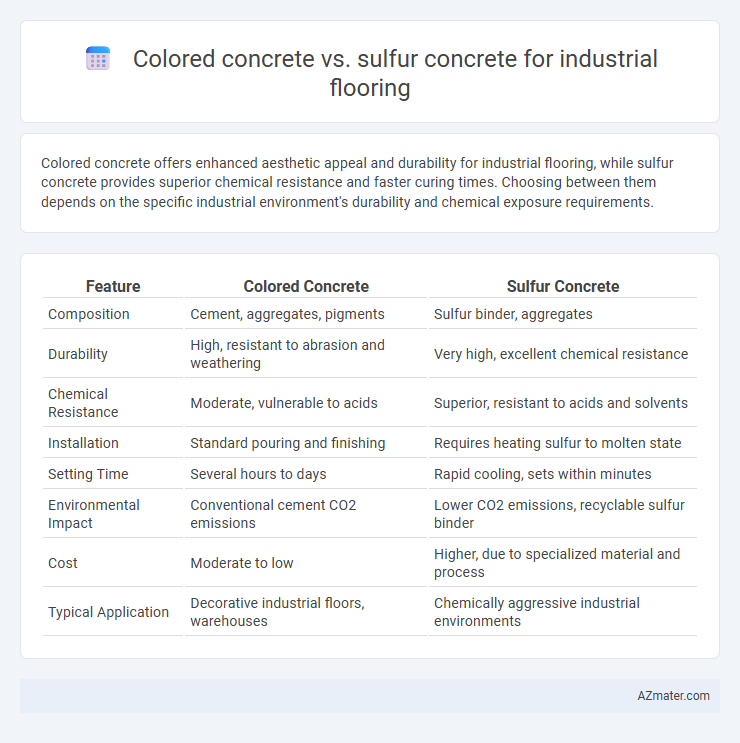Colored concrete offers enhanced aesthetic appeal and durability for industrial flooring, while sulfur concrete provides superior chemical resistance and faster curing times. Choosing between them depends on the specific industrial environment's durability and chemical exposure requirements.
Table of Comparison
| Feature | Colored Concrete | Sulfur Concrete |
|---|---|---|
| Composition | Cement, aggregates, pigments | Sulfur binder, aggregates |
| Durability | High, resistant to abrasion and weathering | Very high, excellent chemical resistance |
| Chemical Resistance | Moderate, vulnerable to acids | Superior, resistant to acids and solvents |
| Installation | Standard pouring and finishing | Requires heating sulfur to molten state |
| Setting Time | Several hours to days | Rapid cooling, sets within minutes |
| Environmental Impact | Conventional cement CO2 emissions | Lower CO2 emissions, recyclable sulfur binder |
| Cost | Moderate to low | Higher, due to specialized material and process |
| Typical Application | Decorative industrial floors, warehouses | Chemically aggressive industrial environments |
Introduction to Industrial Flooring Materials
Industrial flooring demands materials that offer high durability, chemical resistance, and load-bearing capacity. Colored concrete provides enhanced aesthetic customization with embedded pigments while maintaining strong mechanical properties suited for heavy industrial use. Sulfur concrete delivers superior chemical and corrosion resistance with rapid setting times, making it ideal for harsh environments requiring minimal downtime.
What is Colored Concrete?
Colored concrete is a type of concrete that incorporates pigments or dyes to achieve a specific color, enhancing its aesthetic appeal for industrial flooring applications. It is highly durable, resistant to wear, and can be customized to match branding or safety color codes, making it suitable for warehouses, manufacturing plants, and commercial facilities. Unlike sulfur concrete, which uses sulfur as a binder for chemical resistance, colored concrete relies on traditional cementitious materials, offering better mechanical strength and versatility in design.
Understanding Sulfur Concrete
Sulfur concrete offers superior chemical resistance and rapid setting times compared to traditional colored concrete, making it ideal for industrial flooring exposed to harsh chemicals and extreme temperatures. This thermoplastic composite material solidifies quickly, reducing downtime in industrial environments while providing excellent durability and low permeability. Understanding sulfur concrete involves recognizing its advantages in sustainability, as it utilizes byproduct sulfur, and its capacity to withstand heavy mechanical stress without significant degradation.
Color Customization and Aesthetics
Colored concrete offers extensive color customization through integral pigments, stains, and dyes, enabling vibrant, uniform, and long-lasting hues ideal for industrial flooring requiring aesthetic appeal and brand alignment. Sulfur concrete, while less flexible in color options, provides natural dark tones and limited pigmentation, making it suitable for environments prioritizing chemical resistance over diverse color palettes. Industrial flooring projects aiming for unique, precise aesthetic customization typically favor colored concrete for its superior color retention and variety.
Mechanical Strength and Durability Comparison
Colored concrete offers high compressive strength typically ranging from 20 to 40 MPa, making it suitable for heavy industrial loads, while sulfur concrete exhibits superior tensile strength and chemical resistance due to its polymeric sulfur binder. Sulfur concrete demonstrates exceptional durability against acids, sulfates, and abrasion, outperforming colored concrete in corrosive industrial environments, though it may have lower thermal stability. Both materials provide robust flooring solutions, but sulfur concrete's enhanced resistance to aggressive chemicals and faster setting time offer significant advantages for industrial spaces requiring long-term durability under harsh conditions.
Chemical Resistance in Industrial Environments
Colored concrete offers moderate chemical resistance suitable for environments with occasional exposure to oils, acids, and alkalis, making it versatile for many industrial flooring applications. Sulfur concrete dramatically outperforms traditional colored concrete in chemical resistance, providing exceptional durability against aggressive chemicals such as solvents, sulfates, and chlorides commonly found in industrial settings. The superior chemical inertness of sulfur concrete minimizes surface degradation and maintenance costs, enhancing long-term performance in highly corrosive environments.
Installation Process and Time Factors
Colored concrete offers a straightforward installation process involving standard mixing, pouring, and finishing, allowing rapid curing times typically within 24 to 48 hours, which supports quicker project turnover. Sulfur concrete requires heating sulfur to around 130-150degC before mixing with aggregates, and the cooling period for solidification can extend the installation time despite its chemical resistance benefits. Choosing between these materials depends on balancing installation speed with durability requirements, as colored concrete suits faster deployment while sulfur concrete demands more time but provides superior chemical resistance.
Maintenance and Longevity Considerations
Colored concrete offers durable and visually appealing industrial flooring with moderate maintenance requirements, needing periodic sealing to preserve color and prevent surface wear. Sulfur concrete provides exceptional chemical resistance and rapid curing times, resulting in low maintenance demands and superior longevity in harsh industrial environments. Choosing between them depends on specific operational conditions, desired aesthetic appeal, and the balance between initial installation cost and long-term durability.
Environmental Impact and Sustainability
Colored concrete, primarily composed of Portland cement, aggregates, and pigments, has a significant carbon footprint due to cement production, accounting for approximately 8% of global CO2 emissions. Sulfur concrete utilizes molten sulfur as a binder, which can incorporate industrial by-products like recycled sulfur from petroleum refining, reducing waste and lowering greenhouse gas emissions during manufacture. The recyclability of sulfur concrete enhances its sustainability by allowing it to be reheated and reused without degradation, whereas colored concrete is more challenging to recycle and often ends up in landfills, contributing to environmental concerns.
Cost Analysis: Colored Concrete vs Sulfur Concrete
Colored concrete generally offers a more cost-effective solution for industrial flooring due to lower raw material and installation expenses compared to sulfur concrete, which involves specialized sulfur-based binders and equipment. Sulfur concrete's higher upfront costs are offset by its superior chemical resistance and quicker curing times, potentially reducing long-term maintenance and downtime expenses. Evaluating total lifecycle costs, including durability and operational impact, is crucial when comparing these materials for industrial flooring applications.

Infographic: Colored concrete vs Sulfur concrete for Industrial flooring
 azmater.com
azmater.com